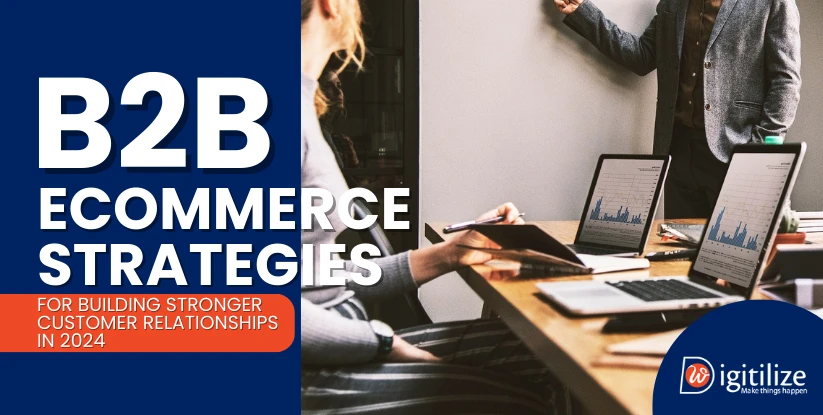B2B Ecommerce Strategies for Building Stronger Customer Relationships in 2024
 One of the sectors in the globe that is expanding the quickest is ecommerce. According to a report, global ecommerce sales would exceed $6.4 trillion by 2024. Nevertheless, it might be difficult to stand out and boost sales when there are so many ecommerce companies vying for the same clients. To draw in, hold on to, and convert their target customer base, ecommerce businesses must continuously innovate and improve their tactics. So, read the blog to know the B2B e-commerce customer relationship strategies UK in 2024.
Every procedure has to be as automated as feasible to fulfil the demands of a business-to-business user. At least 80% of B2B purchasers, according to B2B ecommerce trends, anticipate a B2C-like experience from the businesses they select. A significant proportion of B2B enterprises who experimented with personalized B2B shopping experiences report that it significantly improved their outcomes.
One of the sectors in the globe that is expanding the quickest is ecommerce. According to a report, global ecommerce sales would exceed $6.4 trillion by 2024. Nevertheless, it might be difficult to stand out and boost sales when there are so many ecommerce companies vying for the same clients. To draw in, hold on to, and convert their target customer base, ecommerce businesses must continuously innovate and improve their tactics. So, read the blog to know the B2B e-commerce customer relationship strategies UK in 2024.
Every procedure has to be as automated as feasible to fulfil the demands of a business-to-business user. At least 80% of B2B purchasers, according to B2B ecommerce trends, anticipate a B2C-like experience from the businesses they select. A significant proportion of B2B enterprises who experimented with personalized B2B shopping experiences report that it significantly improved their outcomes.
B2B eCommerce: What is it?
B2B eCommerce means businesses sell products or services online to other businesses. This is different from B2C eCommerce, where the target is individual consumers.
The B2B sales process usually takes more time. Why? Because it often involves multiple decision-makers, larger order sizes, and higher costs. These factors slow down the buying journey.
One of the top industries using B2B eCommerce is manufacturing. Manufacturers produce parts in bulk and sell them to other companies. For example, one company might make microchips. Apple buys those chips and uses them to build iPhones, which are then sold to end-users.
In recent years, things have shifted. Events like COVID-19 pushed many businesses to change direction. Some went direct-to-consumer (D2C). Others moved from traditional sales to digital-first B2B (D2B). In 2025, more B2B companies are speeding up their digital transformation. They know the future is online.
Even though manufacturing companies still lead in B2B eCommerce, the model now suits many other sectors. It’s not just about factories and hardware anymore.
What matters most in B2B eCommerce is knowing your audience. Segment your market. Offer the right product to the right buyer. You don’t need to sell only to manufacturers. Any business client can benefit from bulk buying or product variations.
By focusing on clear value and smooth buying experiences, your B2B eCommerce business can grow in 2025 and beyond.
The Top 12 Worldwide Strategies for B2B eCommerce Marketplaces to Take Over the Market in 2024
 Because internet shopping is so convenient, having a strong online store may help you both draw in new customers and provide your existing ones the best practices for B2B e-commerce in the UK.
The B2B eCommerce market is growing rapidly. Therefore, in order to stay relevant and expand, sellers need to use innovative worldwide B2B eCommerce marketplace-winning strategies. To outperform other vendors, you need to understand the mindset of B2B buyers, plan for long-term growth, and develop creative relationship-building techniques. Let’s look at the best B2B ecommerce marketplace tactics for growing your business.
Because internet shopping is so convenient, having a strong online store may help you both draw in new customers and provide your existing ones the best practices for B2B e-commerce in the UK.
The B2B eCommerce market is growing rapidly. Therefore, in order to stay relevant and expand, sellers need to use innovative worldwide B2B eCommerce marketplace-winning strategies. To outperform other vendors, you need to understand the mindset of B2B buyers, plan for long-term growth, and develop creative relationship-building techniques. Let’s look at the best B2B ecommerce marketplace tactics for growing your business.
-
Examine the B2B Buyers’ Psychological State
Among the many B2B eCommerce marketplace tactics, take into account that buyers are margin-focused. That is the main focus of their business. They are also aware that your price may cause them to lose out on larger profit margins. This is one of the B2B ecommerce strategies for building stronger customer relationships in 2024.
Concerns for B2B customers include the item’s quality, certainty, and potential to give them a competitive edge in the now and the future. When they trade on your marketplace, a B2B buyer has a rational, multi-level consideration set with them. As previously said, the companies who buy from you rely on you for their profit margins and, thus, their existence. You have the ability to create or break them, thus they are seriously in danger. Thus, it is evident why a great deal of reputable businesses are reluctant to use B2B markets.
-
Make Self-Service Available To Customers
The earlier research exposes the significance of self-service for B2B clients. They desire to peruse the merchandise offered on your online storefronts and make personal purchases. According to 41% of respondents, one of the best methods for B2B companies to streamline online business transactions is through the use of self-service capability. Your customers want to talk to you, but they want to finish their homework first. Considering that many high-ticket B2B orders require human engagement to assist the transaction through to completion, think about enabling your website to link directly with your salespeople’s calendars from within the organisation. This is one of the B2B ecommerce strategies for building stronger customer relationships in 2024. When developing strategies for B2B ecommerce marketplaces, customer insights are essential. Develop a friendship with the people you assist.
-
Highlighting Product Specifications and Features
 Customer research continues throughout the purchase process, even though it starts with the sales funnel. Your eCommerce websites should make it easy for customers to locate the answers they need. Customers are more likely to leave if they have to look for information before finding what they need. Consider including a “question and answer” section on your website so that visitors may interact with your product mix and ask questions right away. This is one of the B2B ecommerce strategies for building stronger customer relationships in 2024. This incremental material will also support SEO efforts because it will be updated with relevant, new content. In product descriptions using bullets, enumerate the attributes of certain items.
Customer research continues throughout the purchase process, even though it starts with the sales funnel. Your eCommerce websites should make it easy for customers to locate the answers they need. Customers are more likely to leave if they have to look for information before finding what they need. Consider including a “question and answer” section on your website so that visitors may interact with your product mix and ask questions right away. This is one of the B2B ecommerce strategies for building stronger customer relationships in 2024. This incremental material will also support SEO efforts because it will be updated with relevant, new content. In product descriptions using bullets, enumerate the attributes of certain items.
-
Give Priority to Social Interactions
Two major benefits that social media provides to B2B ecommerce organisations are engagement and learning. As a consequence, by interacting more on social media platforms, firms may increase their visibility and establish more casual connections with customers. Social commerce is made possible via social networking. In a year that postponements conferences across many industries, online meet-ups and digital strategies for B2B customer loyalty webinars gained prominence. Any doubt over the advantages of online networking was resolved by the epidemic. This is one of the B2B ecommerce strategies for building stronger customer relationships in 2024. There is another way to utilise social media as a listening tool. Sales teams may therefore better understand the demands of their clients and adjust their business models by utilising B2B eCommerce marketplace
techniques.
-
Invest in Headless Commerce Systems
B2B companies may separate their website’s front-end and back-end elements with the help of headless commerce architecture. Encouraging them to building trust in B2B e-commerce relationships and customise different components based on their own tastes. Due to its ability to streamline the creation and delivery of personalised shopping experiences, the headless method has gained popularity. Headless architecture reduces website-related costs by streamlining the process of doing so and does away with the need for technical support when small changes made to the front end require adjustments made to the back end.
-
In B2B, generative AI will begin to be used.
These days, GenAI is all the rage, but very few companies are really benefiting from it. About 25% of businesses in a new window won’t see a return on investment from GenAI technology by 2024, according to survey. However, integrating GenAI has a number of advantages when done right, such as:
Creating content for product pages that is appropriate for the brand’s message to the buyer’s preferences. Setting leads as a top priority can help the sales team find quality leads faster, which will increase win rates. This is one of the B2B ecommerce strategies for building stronger customer relationships in 2024. Simplify the procurement process to cut down on mistakes, free up time for strategic decision-making, and automate repetitive chores like order processing and vendor interactions. By evaluating real-time data, give priceless market insights and support product development, providing companies with useful data on rivals, industry trends, and price dynamics.
To provide consumers with an enhancing B2B customer loyalty in e-commerce and customized experience, B2B platforms may make investments in mobile applications. B2B mobile applications have the potential to improve user engagement, introduce new features, and fortify customer relationships. Product details, supporting materials, and documentation are all included in B2B content that is provided in a mobile-friendly way. Users may now easily access vital information from their mobile devices thanks to this guarantee. This is one of the B2B ecommerce strategies for building stronger customer relationships in 2024.
Businesses see the value of meeting the demands and preferences of professionals who increasingly rely on mobile devices for work by implementing a mobile-first strategy in the B2B market. This approach fits in with the larger trends in mobile technology and business interactions, making B2B ecommerce more smooth and effective.
-
Ecommerce Will Become More Sustainable
A significant upsurge is expected, according to the poll, with B2B ecommerce expected to grow from $1.7 trillion in 2021 to $3 trillion by 2027. “Green” ecommerce is one of the major themes that characterise the present state of B2B ecommerce. This is one of the B2B ecommerce strategies for building stronger customer relationships in 2024.
The rise of sustainable practices is one of the most noticeable changes that the B2B e-commerce industry is experiencing. Consumer demands for businesses to operate ethically and environmental awareness are the driving forces behind this growing trend. A number of B2B companies are increasingly incorporating sustainability as a central component of their operations. Eco-friendly techniques are becoming the priority in supply chains, from sourcing to transportation, as they undergo a “green” transition. Businesses are embracing recyclable and biodegradable packaging as it continues to evolve.
-
The use of dynamic pricing will grow in popularity
 Dynamic pricing is about to become a popular B2B ecommerce idea. Even while the vacation rental business has long employed this tactic, the eCommerce sector has recently been interested in its use. B2B companies now have more control over their pricing strategies because to advancements in technology. This is one of the B2B ecommerce strategies for building stronger customer retention for B2B e-commerce in 2024. This gives businesses the ability to explore the idea of using variations in supply and demand to modify their prices in real-time. Adopting real-time pricing might help B2B organizations stay competitive in light of the current spike in inflation rates. It might not only help with more effective pricing control but also improve the customized client experience.
Dynamic pricing is about to become a popular B2B ecommerce idea. Even while the vacation rental business has long employed this tactic, the eCommerce sector has recently been interested in its use. B2B companies now have more control over their pricing strategies because to advancements in technology. This is one of the B2B ecommerce strategies for building stronger customer retention for B2B e-commerce in 2024. This gives businesses the ability to explore the idea of using variations in supply and demand to modify their prices in real-time. Adopting real-time pricing might help B2B organizations stay competitive in light of the current spike in inflation rates. It might not only help with more effective pricing control but also improve the customized client experience.
-
The growing significance of openness
Earlier, buyers met suppliers face-to-face at trade shows or industry events. They discussed things like product quality and pricing in person. But times have changed. In 2025, most of these talks happen online through B2B eCommerce marketplaces.
Even with this shift, buyers still care deeply about price and quality. That hasn’t changed.
One of the top B2B eCommerce strategies today is building stronger customer relationships through trust. To do this, companies must focus on being fully transparent. Buyers want clear, honest details about product quality and pricing.
Transparency isn’t a new idea. But now, it matters more than ever. Along with quality and cost, buyers also expect accurate delivery timelines. They want to know exactly when their orders will arrive.
B2B eCommerce companies in the UK can build long-term loyalty by providing this level of clarity. The more upfront you are, the more trust you earn.
-
One important source of income will be after-sales support.
With the smart use of technology, B2B companies may now generate significant income through after-sales services. Self-service platforms and order histories can be used to recommend upgrades or repair services, make repeat orders easier, and identify relevant spare parts. After-sales services have the potential to increase market participants’ overall income by 50%, per the analysis. Remarkably, a lot of businesses already derive 50% of their total income from this arena.
-
Increasing interest in real-time inventories
Presenting their stock availability accurately will become a more and more important B2B ecommerce trend shortly. In essence, when customers place orders, they need to know the available stock levels. This is one of the B2B ecommerce strategies for building stronger customer relationships in 2024. Real-time inventory updates can provide clients with the crucial assurance that their orders will be fulfilled on time. If your company does not currently have such a system in place, thinking about putting one in place will prove to be a wise investment for the years to come, beginning in 2023.
By 2024, B2B ecommerce marketplace will have undergone a radical change. Businesses need to handle the issues and difficulties mentioned in this article if they want to master the future. You can improve your B2B ecommerce strategy and set yourself up for success by analyzing the demands of your audience, emphasizing customization, using data, and making the appropriate technological investments. For more follow us on Facebook.
Frequently Asked Questions
In 2024, a number of factors, such as cutting-edge technology, a trend towards sustainability, and an emphasis on worldwide development, will drive the maturity of the B2B eCommerce industry.
By automating procedures, forecasting customer behaviour, and making tailored suggestions, AI integration improves B2B operations efficiency and eventually boosts overall business profitability.
Sustainability plays a major role in the maturing process as companies realise how important it is to implement eco-friendly procedures.
It is anticipated that B2B marketing will persist on its path of innovation and metamorphosis in 2024, propelled by technological breakthroughs, evolving client demands, and the introduction of powerful artificial intelligence technologies.
It has been observed that a B2B campaign's success is determined by the total efficacy of four essential components of B2B marketing: Metrics, Creative, Strategy, and Insight.
B2B buyers of today desire the same simple, customised shopping experience that they get from their consumer life. A customised experience is crucial, even for business-to-business buyers, and speed is unavoidable.
 One of the sectors in the globe that is expanding the quickest is ecommerce. According to a report, global ecommerce sales would exceed $6.4 trillion by 2024. Nevertheless, it might be difficult to stand out and boost sales when there are so many ecommerce companies vying for the same clients. To draw in, hold on to, and convert their target customer base, ecommerce businesses must continuously innovate and improve their tactics. So, read the blog to know the B2B e-commerce customer relationship strategies UK in 2024.
Every procedure has to be as automated as feasible to fulfil the demands of a business-to-business user. At least 80% of B2B purchasers, according to B2B ecommerce trends, anticipate a B2C-like experience from the businesses they select. A significant proportion of B2B enterprises who experimented with personalized B2B shopping experiences report that it significantly improved their outcomes.
One of the sectors in the globe that is expanding the quickest is ecommerce. According to a report, global ecommerce sales would exceed $6.4 trillion by 2024. Nevertheless, it might be difficult to stand out and boost sales when there are so many ecommerce companies vying for the same clients. To draw in, hold on to, and convert their target customer base, ecommerce businesses must continuously innovate and improve their tactics. So, read the blog to know the B2B e-commerce customer relationship strategies UK in 2024.
Every procedure has to be as automated as feasible to fulfil the demands of a business-to-business user. At least 80% of B2B purchasers, according to B2B ecommerce trends, anticipate a B2C-like experience from the businesses they select. A significant proportion of B2B enterprises who experimented with personalized B2B shopping experiences report that it significantly improved their outcomes.
 Because internet shopping is so convenient, having a strong online store may help you both draw in new customers and provide your existing ones the best practices for B2B e-commerce in the UK.
The B2B eCommerce market is growing rapidly. Therefore, in order to stay relevant and expand, sellers need to use innovative worldwide B2B eCommerce marketplace-winning strategies. To outperform other vendors, you need to understand the mindset of B2B buyers, plan for long-term growth, and develop creative relationship-building techniques. Let’s look at the best B2B ecommerce marketplace tactics for growing your business.
Because internet shopping is so convenient, having a strong online store may help you both draw in new customers and provide your existing ones the best practices for B2B e-commerce in the UK.
The B2B eCommerce market is growing rapidly. Therefore, in order to stay relevant and expand, sellers need to use innovative worldwide B2B eCommerce marketplace-winning strategies. To outperform other vendors, you need to understand the mindset of B2B buyers, plan for long-term growth, and develop creative relationship-building techniques. Let’s look at the best B2B ecommerce marketplace tactics for growing your business.
 Customer research continues throughout the purchase process, even though it starts with the sales funnel. Your eCommerce websites should make it easy for customers to locate the answers they need. Customers are more likely to leave if they have to look for information before finding what they need. Consider including a “question and answer” section on your website so that visitors may interact with your product mix and ask questions right away. This is one of the B2B ecommerce strategies for building stronger customer relationships in 2024. This incremental material will also support SEO efforts because it will be updated with relevant, new content. In product descriptions using bullets, enumerate the attributes of certain items.
Customer research continues throughout the purchase process, even though it starts with the sales funnel. Your eCommerce websites should make it easy for customers to locate the answers they need. Customers are more likely to leave if they have to look for information before finding what they need. Consider including a “question and answer” section on your website so that visitors may interact with your product mix and ask questions right away. This is one of the B2B ecommerce strategies for building stronger customer relationships in 2024. This incremental material will also support SEO efforts because it will be updated with relevant, new content. In product descriptions using bullets, enumerate the attributes of certain items.
 Dynamic pricing is about to become a popular B2B ecommerce idea. Even while the vacation rental business has long employed this tactic, the eCommerce sector has recently been interested in its use. B2B companies now have more control over their pricing strategies because to advancements in technology. This is one of the B2B ecommerce strategies for building stronger customer retention for B2B e-commerce in 2024. This gives businesses the ability to explore the idea of using variations in supply and demand to modify their prices in real-time. Adopting real-time pricing might help B2B organizations stay competitive in light of the current spike in inflation rates. It might not only help with more effective pricing control but also improve the customized client experience.
Dynamic pricing is about to become a popular B2B ecommerce idea. Even while the vacation rental business has long employed this tactic, the eCommerce sector has recently been interested in its use. B2B companies now have more control over their pricing strategies because to advancements in technology. This is one of the B2B ecommerce strategies for building stronger customer retention for B2B e-commerce in 2024. This gives businesses the ability to explore the idea of using variations in supply and demand to modify their prices in real-time. Adopting real-time pricing might help B2B organizations stay competitive in light of the current spike in inflation rates. It might not only help with more effective pricing control but also improve the customized client experience.

